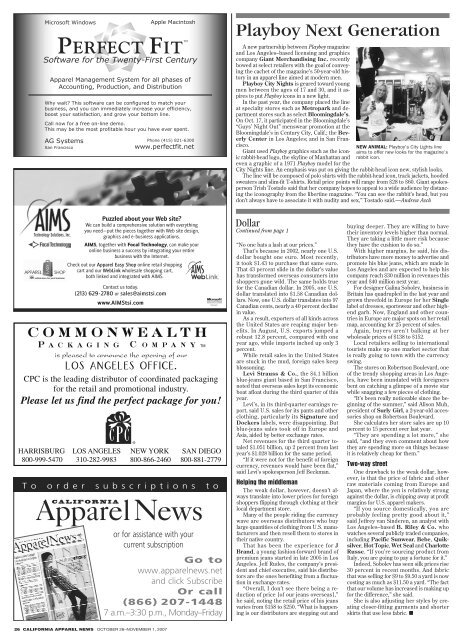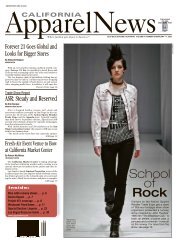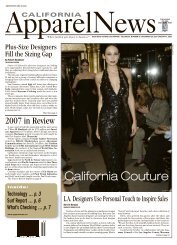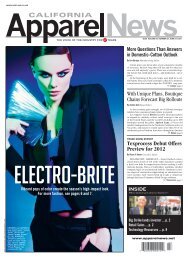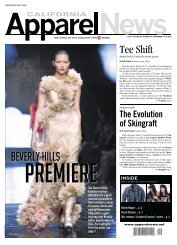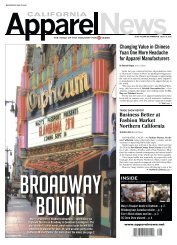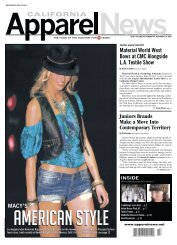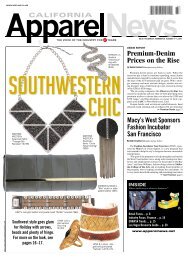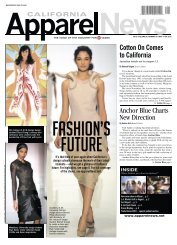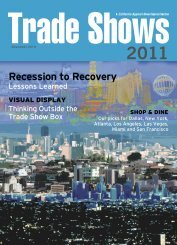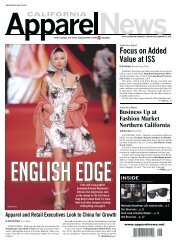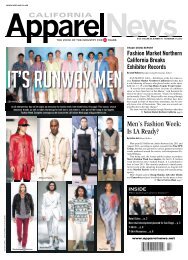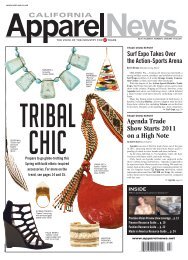18_can102607lettersi.. - California Apparel News
18_can102607lettersi.. - California Apparel News
18_can102607lettersi.. - California Apparel News
You also want an ePaper? Increase the reach of your titles
YUMPU automatically turns print PDFs into web optimized ePapers that Google loves.
Microsoft Windows Apple Macintosh<br />
TM<br />
PERFECT FIT<br />
Software for the Twenty-First Century<br />
<strong>Apparel</strong> Management System for all phases of<br />
Accounting, Production, and Distribution<br />
Why wait? This software can be configured to match your<br />
business, and you can immediately increase your efficiency,<br />
boost your satisfaction, and grow your bottom line.<br />
Call now for a free on-line demo.<br />
This may be the most profitable hour you have ever spent.<br />
AG Systems<br />
San Francisco<br />
��������������������������<br />
Phone (415) 821-6300<br />
www.perfectfit.net<br />
����������������������������<br />
�����������������������������������������������������<br />
������������������������������������������������������<br />
�������������������������������������<br />
����������������������������������������������������<br />
�����������������������������������������������������<br />
���������������������������<br />
������������������������������� ����������������������<br />
�������������������� �������������������������<br />
�������������������������������������<br />
�����������������<br />
�������������� ��������������������<br />
���������������<br />
To order subscriptions to<br />
CALIFORNIA<br />
<strong>Apparel</strong> <strong>News</strong><br />
or for assistance with your<br />
current subscription<br />
Go to<br />
www.apparelnews.net<br />
and click Subscribe<br />
Or call<br />
(866) 207-1448<br />
7 a.m.–3:30 p.m., Monday–Friday<br />
26 CALIFORNIA APPAREL NEWS OCTOBER 26–NOVEMBER 1, 2007<br />
Playboy Next Generation<br />
A new partnership between Playboy magazine<br />
and Los Angeles–based licensing and graphics<br />
company Giant Merchandising Inc. recently<br />
bowed at select retailers with the goal of conveying<br />
the cachet of the magazine’s 50-year-old history<br />
in an apparel line aimed at modern men.<br />
Playboy City Nights is geared toward young<br />
men between the ages of 17 and 30, and it aspires<br />
to put Playboy icons in a new light.<br />
In the past year, the company placed the line<br />
at specialty stores such as Metropark and department<br />
stores such as select Bloomingdale’s.<br />
On Oct. 17, it participated in the Bloomingdale’s<br />
“Guys’ Night Out” menswear promotion at the<br />
Bloomingdale’s in Century City, Calif.; the Beverly<br />
Center in Los Angeles; and in San Francisco.<br />
Giant used Playboy graphics such as the iconic<br />
rabbit-head logo, the skyline of Manhattan and<br />
even a graphic of a 1971 Playboy model for the<br />
City Nights line. An emphasis was put on giving the rabbit-head icon new, stylish looks.<br />
The line will be composed of polo shirts with the rabbit-head icon, track jackets, hooded<br />
sweaters and slim-fit T-shirts. Retail price points will range from $28 to $60. Giant spokesperson<br />
Trish Tostado said that her company hopes to appeal to a wide audience by distancing<br />
the iconography from the libertine magazine. “You can see the rabbit’s head, but you<br />
don’t always have to associate it with nudity and sex,” Tostado said.—Andrew Asch<br />
Dollar<br />
Continued from page 1<br />
“No one bats a lash at our prices.”<br />
That’s because in 2002, nearly one U.S.<br />
dollar bought one euro. Most recently,<br />
it took $1.43 to purchase that same euro.<br />
That 43 percent slide in the dollar’s value<br />
has transformed overseas consumers into<br />
shoppers gone wild. The same holds true<br />
for the Canadian dollar. In 2005, one U.S.<br />
dollar translated into $1.58 Canadian dollars.<br />
Now, one U.S. dollar translates into 97<br />
Canadian cents, nearly a 40 percent decline<br />
in value.<br />
As a result, exporters of all kinds across<br />
the United States are reaping major benefits.<br />
In August, U.S. exports jumped a<br />
robust 12.8 percent, compared with one<br />
year ago, while imports inched up only 3<br />
percent.<br />
While retail sales in the United States<br />
are stuck in the mud, foreign sales keep<br />
blossoming.<br />
Levi Strauss & Co., the $4.1 billion<br />
blue-jeans giant based in San Francisco,<br />
noted that overseas sales kept its economic<br />
boat afloat during the third quarter of this<br />
year.<br />
Levi’s, in its third-quarter earnings report,<br />
said U.S. sales for its pants and other<br />
clothing, particularly its Signature and<br />
Dockers labels, were disappointing. But<br />
blue-jeans sales took off in Europe and<br />
Asia, aided by better exchange rates.<br />
Net revenues for the third quarter totaled<br />
$1.051 billion, up 2 percent from last<br />
year’s $1.028 billion for the same period.<br />
“If it were not for the benefit of foreign<br />
currency, revenues would have been flat,”<br />
said Levi’s spokesperson Jeff Beckman.<br />
Helping the middleman<br />
The weak dollar, however, doesn’t always<br />
translate into lower prices for foreign<br />
shoppers flipping through clothing at their<br />
local department store.<br />
Many of the people riding the currency<br />
wave are overseas distributors who buy<br />
large quantities of clothing from U.S. manufacturers<br />
and then resell them to stores in<br />
their native country.<br />
That has been the experience for J<br />
Brand, a young fashion-forward brand of<br />
premium jeans started in late 2005 in Los<br />
Angeles. Jeff Rudes, the company’s president<br />
and chief executive, said his distributors<br />
are the ones benefiting from a fluctuation<br />
in exchange rates.<br />
“Overall, I don’t see there being a reduction<br />
of price [of our jeans overseas],”<br />
he said, noting the retail price of his jeans<br />
varies from $158 to $250. “What is happening<br />
is our distributors are stepping out and<br />
NEW ANIMAL: Playboy’s City Lights line<br />
aims to offer new looks for the magazine’s<br />
rabbit icon.<br />
buying deeper. They are willing to have<br />
their inventory levels higher than normal.<br />
They are taking a little more risk because<br />
they have the cushion to do so.”<br />
With higher margins, he said, his distributors<br />
have more money to advertise and<br />
promote his blue jeans, which are made in<br />
Los Angeles and are expected to help his<br />
company reach $30 million in revenues this<br />
year and $40 million next year.<br />
For designer Galina Sobolev, business in<br />
Britain has quadrupled in the last year and<br />
grown threefold in Europe for her Single<br />
label of dresses, sportswear and other highend<br />
garb. Now, England and other countries<br />
in Europe are major spots on her retail<br />
map, accounting for 25 percent of sales.<br />
Again, buyers aren’t balking at her<br />
wholesale prices of $138 to $152.<br />
Local retailers selling to international<br />
tourists make up one market sector that<br />
is really going to town with the currency<br />
swing.<br />
The stores on Robertson Boulevard, one<br />
of the trendy shopping areas in Los Angeles,<br />
have been inundated with foreigners<br />
bent on catching a glimpse of a movie star<br />
while snagging a few pieces of clothing.<br />
“It’s been really noticeable since the beginning<br />
of the summer,” said Alison Muh,<br />
president of Surly Girl, a 2-year-old accessories<br />
shop on Robertson Boulevard.<br />
She calculates her store sales are up 10<br />
percent to 15 percent over last year.<br />
“They are spending a lot more,” she<br />
said, “and they even comment about how<br />
they are spending more on things because<br />
it is relatively cheap for them.”<br />
Two-way street<br />
One drawback to the weak dollar, however,<br />
is that the price of fabric and other<br />
raw materials coming from Europe and<br />
Japan, where the yen is relatively strong<br />
against the dollar, is chipping away at profit<br />
margins for U.S. apparel makers.<br />
“If you source domestically, you are<br />
probably feeling pretty good about it,”<br />
said Jeffrey van Sinderen, an analyst with<br />
Los Angeles–based B. Riley & Co. who<br />
watches several publicly traded companies,<br />
including Pacific Sunwear, Bebe, Quiksilver,<br />
Hot Topic, Wet Seal and Charlotte<br />
Russe. “If you’re sourcing product from<br />
Italy, you are going to pay a fortune for it.”<br />
Indeed, Sobolev has seen silk prices rise<br />
30 percent in recent months. And fabric<br />
that was selling for $9 to $9.50 a yard is now<br />
costing as much as $11.50 a yard. “The fact<br />
that our volume has increased is making up<br />
for the difference,” she said.<br />
She is also adjusting her styles by creating<br />
closer-fitting garments and shorter<br />
skirts that use less fabric. ■


